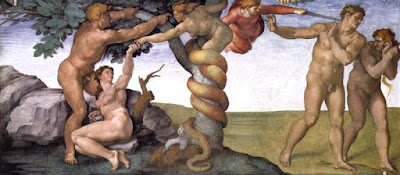
Last Sunday, I had occasion to read Genesis 1:1-2:4a in our worship service. Joanne, our seminary assistant, was preaching, and had chosen that passage from out of the Revised Common Lectionary selections for the day.
Not often do I have the opportunity to read that famous passage – the first of Genesis’ two creation stories – aloud, in its entirety.
“God saw everything that he had made, and indeed, it was very good.” (Genesis 1:31) I was struck by the sheer majesty of those ancient words.
Funny that today I should see those very same words pop up in a comment posted on my blog. A reader named Christine referred to Genesis as she commented on the May 18th entry, “The Imperfect Is Our Paradise.” Here’s what she has to say:
“Dear Carl, can you really see God in the immense suffering as a result of the China earthquake or the Myanmar cyclone or in any other tragedies? I truly would like to but how does one begin? Does the answer lie in finding a purpose in the imperfection? I thought the Bible says that when God created the world, he saw that all was good. Perhaps I am missing the point.”Ordinarily, I respond to comments in the Comments section, but Christine’s remarks set me to thinking. The more I think about it, the more I realize that her objection, and my response, belong not just among the comments, but here in prime time.
The theological issue Christine raises is a big one – perhaps the biggest. I’m speaking, of course, about the question theologians call
theodicy: the problem of evil.
Christine puts it bluntly:
“Can YOU really see God in the immense suffering as a result of the China earthquake or the Myanmar cyclone...?” It’s kind of like Jesus’ question to Peter at Caesarea Philippi: “But who do YOU say that I am?” (Christine has a way of putting a preacher on the spot. Which is OK with me. It goes with the territory.)
Well, Christine, let me attempt an answer. Please understand, before I begin, that any answer I attempt can hardly break new ground. This question has both preoccupied and baffled the sharpest theological minds down through the centuries.
Archibald MacLeish put it colorfully, in
J.B., his play in verse based on the book of Job. There, the poet has the devil taunt the long-suffering Job, saying,
“If God is God, he is not good,
if God is good, he is not God,
take the even, take the odd.”The writer of Genesis punctuates his narrrative of creation with the repeated mantra, “And it was good.” But
was it? That’s really what Christine is asking. She wants to know if it
was good through and through, if there were any seeds of evil in that idealized, primordial realm. In other words, was creation perfect? And, if so, what happened to it? How could the loving, omnipotent, “and it was good” God tolerate a world with earthquakes and cyclones in it, let alone Non-Hodgkin Lymphoma?
I’ve spent a fair amount of time wondering about that question myself, over the last several years. As I’ve pondered it, I’ve come to the conviction that creation need not be perfect to be good – at least, not as we commonly understand the word, “perfect.”
Anyone who takes a hard, unblinking look at creation quickly realizes it’s far from perfect. I’m no creationist; I firmly believe God used – and still uses – random processes like Darwin’s natural selection to fashion the universe. Think of the wild profusion of seeds that never make it to fertile soil. Think of the billions of animals gobbled up by larger, fiercer beasts. Think of humans who are blessed with free will, but who turn around and misuse that gift to create everything from
Mein Kampf to child pornography to “Swift Boat Veterans for Truth.” Yes, indeed, creation is a messy business. Sometimes it seems the creator God operates more like Jackson Pollock than Andrew Wyeth: sending shiny strings of paint swirling through the air, spattering as much color upon the floor and walls as ends up on the canvas. Yet, somehow God loves the wild imperfection of it all.
And it was good.It’s an imperfect world, no doubt about it. One strain of thinking within Christianity posits that creation began with perfection, but then something called the Fall intervened, as a saltshaker lid comes unscrewed over a bowl of soup. It blames human sin for the mess. I don’t buy that. There in the Garden, Adam and Eve have free will. The serpent may croon to them seductively, but at the end of the day they choose the forbidden fruit on their own. Adam and Eve have that capacity for choosing wrongly within them, all along – and isn’t it true that God created them, including their capacity to choose evil?

There’s another meaning to the word “perfect,” and this one I can affirm with respect to the creation story. “Perfect” doesn’t only mean “without flaw.” It can also mean “finished.” Like the grammarians’ “perfect tense,” this sort of perfection means just what Genesis 1 asserts: that God created, then God rested. When God rested n the seventh day, the work of creation was finished: flaws and all.
And it was good.When the author of Genesis says it was good, I think he’s using that word the way parents use it of their children: “He’s a good boy, she’s a good girl.” In saying such a thing, parents never mean their offspring are free from errors or flaws. They mean, “They are who they are. What they are is mine, and I love them.”
Yet, this world God created – good as it was, and still is – is far from static. It’s a living, growing thing. God may have perfected it eons ago, speaking a word of love into chaos, but the divine work of creation continues to unfold, through spouting volcanoes, shuddering earthquakes and swirling cyclones. Evolution continues, in its glorious profusion of species – some destined to become ancestors of species yet unborn, others bound only for the scrap heap of extinction. It’s all God’s, and it’s all good.
Could God intervene to prevent a shoddily-constructed Chinese school building from collapsing on the unsuspecting heads of its students? Could God send a cyclone spinning out into the open ocean, rather than letting it careen into a heavily-populated river delta, dotted with fragile bamboo huts?
In theory, God could. But, in practice, God typically won’t. That’s because God values one aspect of creation as especially good, so good it needs to be left alone: creation’s freedom. Were God to begin censoring creation’s every impulse to randomness, then it would cease to be the starkly beautiful place it is. It would become, instead, a wasteland of dreary predictability. The Pollock canvas would be transformed into a Stalinist propaganda poster. The lumpy, fresh-off-the vine tomato would become the perfectly-spherical but tasteless hothouse variety.

Did God create cancer? Maybe not directly, but God did bestow upon creation the gift of freedom. God stepped back and said, “I’m finished. Let it be.” Then there began a wild profusion of changes and mutations, continuing through the eons, even unto our own day. As in all living cells, the DNA in certain cells of the human body eventually mutates, changing the intricate pattern of chemical switches. One of these chemical switches controls the cells’ programmed instructions to die on schedule, making room for new cells. In their wild freedom, the newly-immortal cancer cells grow in size and number, squeezing out their healthier neighbors. Repeat this process millions of times, and the complex creature of which those cells are an essential part falls ill, even dies prematurely. Such a turn of events causes God to weep. Yet, through the tears, God keeps loving creation – enough to refrain from laying hands on it, robbing it of its precious freedom. God continues to call it good.
Ultimately, it’s love that’s at the center of creation. Out of love God fashioned the whole thing in the first place. Out of love God said, “Let us make humankind in our image, according to our likeness.” Out of love, God allows the human prodigal to run free, even if that one is squandering the family fortune. The child’s got to fall before it can walk.
“Love never ends. But as for prophecies, they will come to an end; as for tongues, they will cease; as for knowledge, it will come to an end. For we know only in part, and we prophesy only in part; but when the complete comes, the partial will come to an end.” (1 Corinthians 13:8-10)
The poet Isaiah promises that, one day, God will roll up the whole cosmic burrito, leveling earth’s mountains and raising up the valleys to make a grand processional highway of celebration. Then, there shall be no more weeping, nor crying, nor pain. They shall not hurt or destroy on all God’s holy mountain.
I’m coming to believe Philip Simmons – the ALS survivor whom I quoted, in the blog entry to which Christine took exception – is right. Because of his experience of suffering, he of all people is worthy to be our guide in such matters. The world is imperfect, as we normally define the term. Yet, the world is good, all the same. That good, but imperfect, world can even be our paradise.
It’s the only world we’ve got. Until the day. Until the day...
 I feel a little out of place. I knew Diane from such a narrow segment of her life – the support group – and from a time when she wasn’t feeling her best. These are images of a life that was rich and full, until cancer burst in and overturned the game board, scattering the playing-pieces.
I feel a little out of place. I knew Diane from such a narrow segment of her life – the support group – and from a time when she wasn’t feeling her best. These are images of a life that was rich and full, until cancer burst in and overturned the game board, scattering the playing-pieces.
















